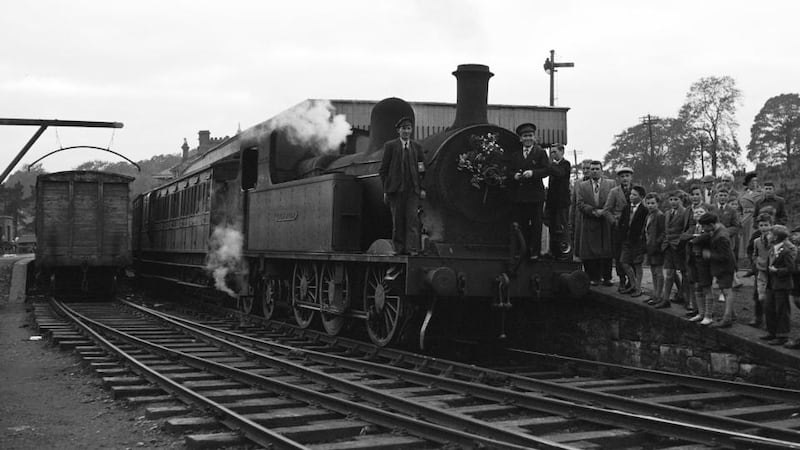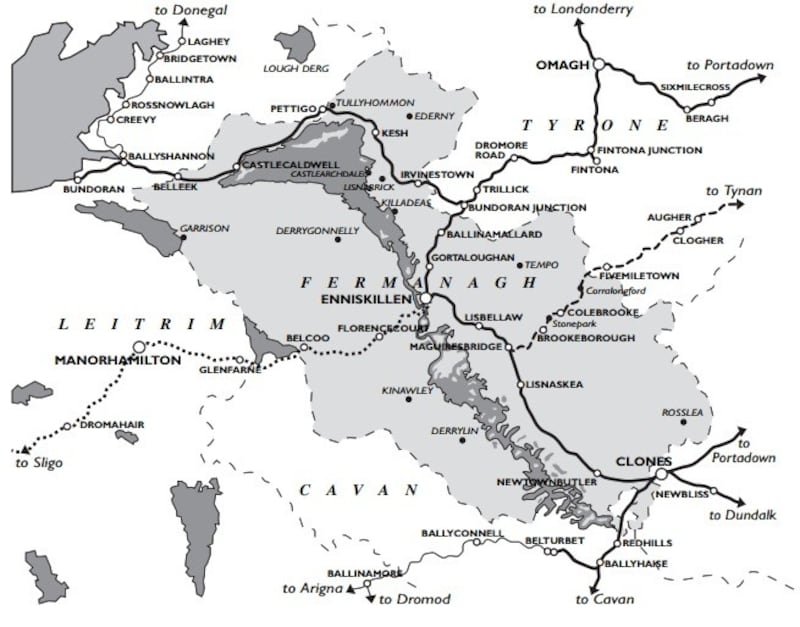Willie Gault, a guard with Sligo, Leitrim and Northern Counties Railway, boarded the train from Enniskillen, Co Fermanagh, to Manorhamilton, Co Leitrim, and back one last time on September 30th, 1957.
He cycled 12 miles from Florencecourt that morning for his final 6.20am shift, as he did every day.
“I remember being in that last car to Manorhamilton and that was me finished; there was nothing much more to do. I was kind of sad when I had got back to Enniskillen,” says Gault (82). “But the driver, he was even sadder than me.”
For Gault and many other employees across northwest Ireland, it was the end of an era. “I had a good enough life after that, but if the railways had not closed I’d still be there,” he says.
The closure of Sligo, Leitrim and Northern Counties Railway, along with the Great Northern Railway, 60 years ago this month left a vast swathe of Northern Ireland and the Republic without rail transport.
Cecil Haire (76) worked for the Great Northern Railway as a steam cleaner when he was 15, the youngest of its employees and the last to be recruited.
Locomotives were in his blood: his father, Wilson, worked at Maguiresbridge station in Co Fermanagh. The family home was at the end of the platform and his dream was to one day drive a train. Less than a year later – on its final day – his wish was granted.
“I was on the last train out of Clones in Co Monaghan and it was a sad time. I can remember coming into the station at Maguiresbridge [in Co Fermanagh] for the final time.
“All I ever wanted to be was an engine driver, but you had to start off as an engine cleaner and work through the ranks. That day the driver, a man called Gussie Kelly, allowed me to drive a bit. Afterwards I shook his hand and never seen him again.”
Haire cycled home, unsure of where his life would take him.
“The bottom fell out of my world when the railways closed,” he says.
Impact on rural towns
Cutting off 200 miles of railway connections had a significant impact on many rural towns such as Bundoran, Clones, Enniskillen, Omagh, Sligo and Armagh, and many small villages in between.
For the farmers who had ferried their cattle to markets via the train, the GAA enthusiasts who went off to Dublin for All-Ireland finals and the pilgrims who flocked to Lough Derg – including a record 22,000 of them in 1952 – it was a vital service that connected two jurisdictions.
At Bundoran in Co Donegal, the last train was sent away by a cheering crowd of 400 people and carried 100 passengers, most of them going to Ballyshannon, near the Fermanagh border.
At Bundoran Junction, which was miles away from the station, there were three signal cabins, a requirement that staff could not serve alcohol unless two trains were at the station and a sign reminding men to adjust their clothes before leaving the toilets.

Trains leaving Clones in Co Monaghan were given a noisy farewell, with hundreds of rail detonators exploding, engines whistling and many locals waving as the diesel train left for Belfast and the stream train left for Enniskillen. It was also the end of the Erne cross-Border bus service that operated north and south for 29 years.
A farewell party
In Enniskillen a crowd of about 150 people gathered to see off the last train of the day, the 6.40pm for Omagh, while the last trains to Clones and Dublin two hours earlier left without ceremony.
Most passenger trains, two or three each weekday in each direction, were operated by railbus or railcar.
Railbuses, recalls Welsh railway enthusiast and photographer Neil Sprinks, were road buses converted for railway use that pulled a luggage trailer behind them, while the diesel railcar was a modern purpose-built vehicle, completed in 1947. They too were withdrawn from service.
“Riding in a railbus was truly memorable,” says Sprinks. “You could imagine yourself in a road bus going down a country lane between the hedges, but you could hear the ding dong as the wheels ran over the joints between the rails, and the driver had no steering wheel.”
Sprinks could not face visiting Enniskillen to watch the final train leave the station.
“Railway closures are sad affairs,” he says. “The people of Enniskillen and Co Fermanagh did not, I think, want to lose their railways. The railway operators wanted to go on, but Stormont had made up its mind.”
Unemployment problem
Enniskillen-born Charles Friel, a railway preservationist, author and photographer, says many of the employees found it difficult to find new work.
“There was a lot of families broke up; one brother would go here, another would go there and a lot of them were on the dole. A 60-year-old man wasn’t very attractive to a new employer.”
Nobody was listening.
“The southern government were very pro-rail because they felt railways kept communities going,” says Friel. “The Northern government, on the other hand, were hell-bent on closing railways and everything had to go by road. It was a time of great sadness and great despair.”

The Sligo Leitrim was the last independent, standard-gauge railway in Ireland, and because it crossed the Border it could not be nationalised in the 1940s and 1950s, when almost all the railways on the island were brought under government ownership. It remained independent from its opening in 1879 until its closure in 1957.
The company did not number its steam locomotives, preferring instead to give them names, usually after local places, such as Lough Gill, Lurganboy and Glencar.
It was a busy line, which transported everything from butter to Belfast, to flagstones from Glenfarne mountain to the Harland and Wolff Shipyard.
Lads off to war
The proximity of Blacklion on the Cavan-Fermanagh Border was such that in 1908 it was agreed to alter the station nameplate to read “Belcoo and Blacklion”, meaning it had the unique distinction of bearing the names of two villages, each in a separate state.
Before its own goodbye, Blacklion shopkeeper Harold Johnston recalls very many sad farewells at Belcoo station as family members emigrating said farewell to parents and family members.
“Lads enlisting to fight in the Great War also left from Belcoo, little knowing of the carnage that was to meet them at the front,” he says.
The Border had a huge effect on the railway line, and a customs post was established at the station.
From then on the post destined for Blacklion had to be in sealed bags, explains Johnston.
Smuggler’s paradise
During rationing times, smuggling was rife as many people crossed the Border to purchase goods that were either unobtainable or rationed in Northern Ireland.
“Engine drivers were coaxed – or maybe even bribed – to slow down near railway crossings where goods could be dropped off at the side of the line and quietly collected later by their owner.
“It was common practice for ladies to wrap lengths of fabric, or even the odd blanket, round themselves under a concealing winter coat.
“One lady, when asked what was under her coat replied coyly, ‘I’ll tell you in six months,’ ” says Johnston, adding that underwear concealed all sorts of groceries such as tea, sugar and butter.
He recalls how one woman smuggled a turkey wrapped up in a shawl, boldly walking up the platform past the customs officer trying to, as she put it, bring the baby’s wind up.
During September, Headhunters Barber Shop and Railway Museum in Enniskillen is organising a series of commemorative events to celebrate the legacy of the railways, including photographic exhibitions, illustrated talks, print and poetry workshops, film screenings and guided tours of railway stations and museum, some conducted in Irish.
“It’s probably one of the largest collections of small Irish railway artefacts and brings the golden age of steam travel to life,” says curator Selwyn Johnston.

















